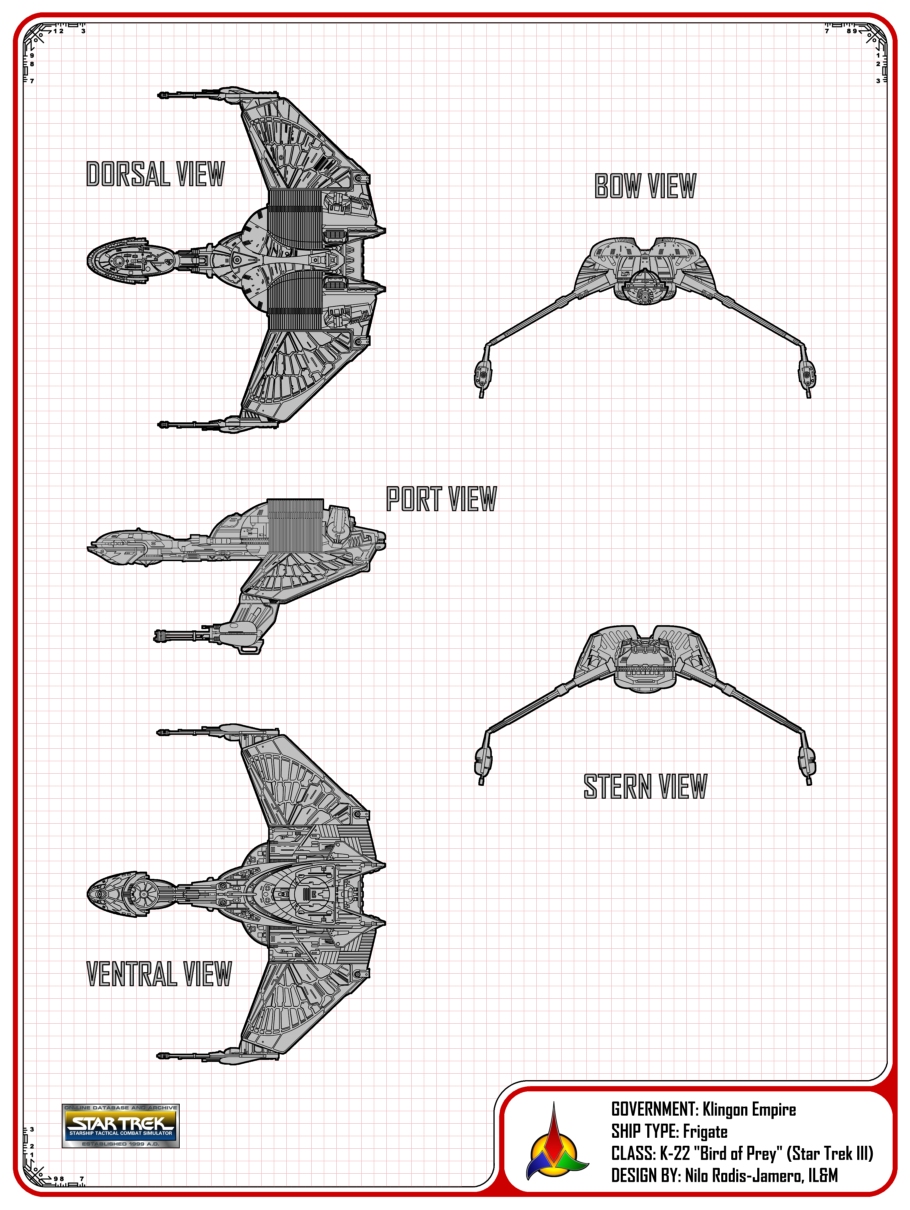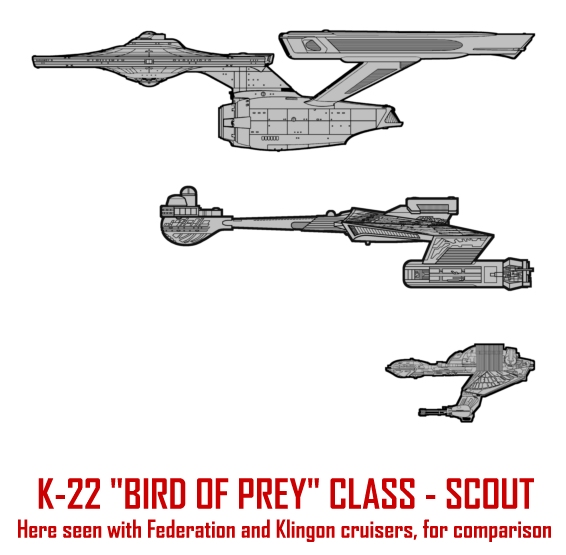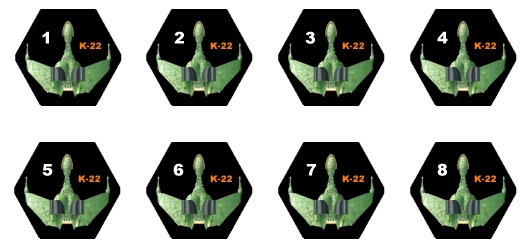|
IN THE SAME WAY that the
Consitution Refit class would inspire an entire new
design aesthetic for Starfleet vessels, the 'Bird of Prey' class would redefine
the Klingon design aesthetic, assuming an altogether sleeker and more predatory
aspect when compared to the older "D7" model as seen in
ST:TOS and
Star Trek TMP and Star Trek II. I've covered most of my opinions on the
'Bird of Prey' in blurbs for the D-32 and the
L-42 ships. Suffice to say
that this smallish Scout is the craft that makes its mark on film first, and in
many ways still defines what the 'Bird of Prey' is all about. This design
was also the basis for much of the new FASA Romulan fleet seen in the Romulan
Ship Recognition Manual—with boom-neck pod and the swept wings with 'feathering'
stamped into the hull. It's hard to calculate exactly how much this single
ship, as it first appeared in Star Trek III, has molded the Klingon ship designs
of ST:TNG and ST:DS9. Certainly it is an intricate and attractive
design. Nilo Rodis-Jamero, working at Industrial Light & Magic, did
fantastic work. At the time of FASA printing this ship was included in both the Romulan
and Klingon inventories, as the conventional Trek wisdom of the mid 1980s
indicated that the Romulans and Klingons were still exchanging technology; and
that the 'Bird of Prey' was more Romulan than Klingon in heritage. The
arrival of ST:TNG and later ST:DS9 obliterated this entire premise, leaving us with
only the tantalizing suggestion in an early Star Trek III script that Kruge stole
his Bird of Prey from the Romulans, before galloping off to the Mutara Sector.
Like all the other "Bird of Prey"
classes, I have created additional stats which take this scout well beyond the
era of Kirk, into the middle period between the launching of the Enterprise-B
and Picard's captaincy of the Enterprise-D. A great number of "Bird
of Prey" ships, of varying sizes and capabilities, operate throughout this
period, and well into the events of ST:TNG and ST:DS9, so I have
tried to give this little ship as much of a fighting chance as I could against
the more advanced enemies it will face in the TNG-era.
—
BRT

From the FASA Star Trek KLINGON SHIP RECOGNITION MANUAL, circa 1985
K-22 (Bird of Prey) Class V-VI Scout
Known Sphere Of Operation: Empire-wide use Data Reliability: D for K-22A; A for K-22B
Major Data Source: K-22B in Star Fleet possession, Klingon Sector Intelligence
The infamous K-22 (Bird Of Prey) scout is the Klingon prong of the double threat posed to Star Fleet by vessels of this design, equipped with cloaking devices and operated by both the Klingon and Romulan navies.
The wing mechanisms of these vessels are ingenious and pratical, the most
interesting feature of the design. When the vessel is cruising, the wings are extended horizontally, which distributes the stress evenly throughout the vessel.
When in combat, the wings are down, which gives a broader field of fire and protects a weak area on the lower central hull.
When performing atmospheric operations, the wings are up, which gives more lift when the 'feather" plates located along the wings, (originally
thought to be merely decorative), are individually adjusted to compensate for air turbulence.
The command pod of the K-22 is a blending of Klingon and Romulan designs, but it cannot be detached in an emergency, for the heart of the ship is located in the main hull, including the computer system and the life-support
system. Also located within the aft hull of the ship are the warp engines, which cannot be jettisoned, as well as the transporter system and the exit ramp.
The cloaking device that is used on this vessel is unreliable at best; it has been confirmed the device is capable of driving crewmembers mad, though Federation medical specialists do not fully understand the cause.
The most important fact concerning the construction of these vessels was that the Klingons already were producing approximately 80% of the internal components prior to
receiving prototypes from the Romulans. On Stardate 2/1805, the Romulans delivered seven hulls and an undetermined number of cloaking devices, and, within 13 months, the Imperial Navy commissioned its first vessels.
The S-11 hulls were fitted out into the K-22A.
As received from the Romulans, they had no mounting point for an aft-firing
disruptor. Intelligence reports indicate that all seven of these vessels were completed, but that afterward no production-model vessels were constructed. The disposition of these seven ships is unknown.
The first production model, the
K-22B, was modified to accept the KD-12. A further modification was made to allow the KSD shielding system to be installed. These systems increase offensive capabilities by 25% and defensive capabilities by 45%.
These vessels are very maneuverable in combat and have an impressive offensive capability.
Although they are not really capable of fighting major warships, they are able to defend themselves long enough to engage their warp systems to escape, with the ability to travel at Warp 8 in emergencies.
The K-22B may be found in all areas of space, performing its missions of espionage and terrorism; they have been reported by Klingon, Triangle, Romulan, and Spinward
Sector Intelligence as operating in those respective areas. The ability of the ship to penetrate outer defenses and travel
freely about the Federation was seen recently, when one of them was captured by
Admiral James T. Kirk. In an attempt to steal the plans of the secret Genesis Project, a K-22B penetrated Federation space undetected as far as the Mutara Nebula.
Most of the information about this class, and the similar Romulan S-11 scout, was obtained from the computer banks of the captured vessel.
Of the 79 K-22Bs built, 1 has been captured by Star Fleet and the remaining 78 are believed to be in active service, their whereabouts unknown.
The K-22 is being produced at the Taamar facility at an approximate rate of 20 per year.
The class name is a reference to the Romulan name for the
S-11; the Klingon name D'Gavama is a direct translation of "bird of prey".
|





